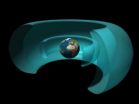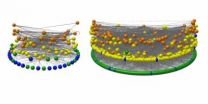(Press-News.org) Scientists have discovered a new, persistent structure in one of two radiation belts surrounding Earth. NASA's twin Van Allen Probes spacecraft have shown that high-energy electrons in the inner radiation belt display a persistent pattern that resembles slanted zebra stripes. Surprisingly, this structure is produced by the slow rotation of Earth, previously considered incapable of affecting the motion of radiation belt particles, which have velocities approaching the speed of light.
Scientists had previously believed that increased solar wind activity was the primary force behind any structures in our planet's radiation belts. However, these zebra stripes were shown to be visible even during low solar wind activity, which prompted a new search for how they were generated. That quest led to the unexpected discovery that the stripes are caused by the rotation of Earth. The findings are reported in the March 20, 2014, issue of Nature.
"It is because of the unprecedented resolution of our energetic particle experiment, RBSPICE, that we now understand that the inner belt electrons are, in fact, always organized in zebra patterns," said Aleksandr Ukhorskiy, lead author of the paper at The Johns Hopkins Applied Physics Laboratory, or APL, in Laurel, Md. "Furthermore, our modeling clearly identifies Earth's rotation as the mechanism creating these patterns. It is truly humbling, as a theoretician, to see how quickly new data can change our understanding of physical properties."
Because of the tilt in Earth's magnetic field axis, the planet's rotation generates an oscillating, weak electric field that permeates through the entire inner radiation belt. To understand how that field affects the electrons, Ukhorskiy suggested imagining that the electrons are like a viscous fluid. The global oscillations slowly stretch and fold the fluid, much like taffy is stretched and folded in a candy store machine. The stretching and folding process results in the striped pattern observed across the entire inner belt, extending from above Earth's atmosphere, about 500 miles above the planet's surface up to roughly 8,000 miles.
The radiation belts are dynamic doughnut-shaped regions around our planet, extending high above the atmosphere, made up of high-energy particles, both electrons and charged particles called ions, which are trapped by Earth's magnetic field. Radiation levels across the belts are affected by solar activity that causes energy and particles to flow into near-Earth space. During active times, radiation levels can dramatically increase, which can create hazardous space weather conditions that harm orbiting spacecraft and endanger humans in space. It is the goal of the Van Allen Probes mission to understand how and why radiation levels in the belts change with time.
"The RBSPICE instrument has remarkably fine resolution and so it was able to bring into focus a phenomena that we previously didn't even know existed," said David Sibeck, the mission scientist for the Van Allen Probes at NASA's Goddard Space Flight Center in Greenbelt, Md. "Better yet, we have a great team of scientists to take advantage of these unprecedented observations: We couldn't have interpreted this data without analysis from strong theoreticians."
NASA launched the Van Allen Probes in the summer of 2012. APL built and operates the probes for NASA's Science Mission Directorate. This is the second mission in NASA's Living With a Star program, which Goddard manages. The program explores aspects of the connected sun-Earth system that directly affect life and society.
INFORMATION:
NASA's Van Allen Probes reveal zebra stripes in space
2014-03-19
ELSE PRESS RELEASES FROM THIS DATE:
Sometimes less is more for hungry dogs
2014-03-19
Hungry dogs would be expected to choose alternatives leading to more food rather than less food. But just as with humans and monkeys, they sometimes show a "less is more" effect. Thus conclude Kristina Pattison and Thomas Zentall of the University of Kentucky in the US, who tested the principle by feeding baby carrots and string cheese to ten dogs of various breeds. The findings are published in Springer's journal Animal Cognition.
The research was conducted on dogs that would willingly eat cheese and baby carrots when offered, but showed a preference for the cheese. ...
Alzheimer's prevention trial to monitor reactions to higher disease risk status
2014-03-19
PHILADELPHIA - A new clinical trial will soon begin testing whether early medical intervention in people at risk for Alzheimer's can slow down progression of disease pathology before symptoms emerge, as outlined in Science Translational Medicine. For the first time, people with no Alzheimer's disease symptoms will be told of their risk status before being asked to join the randomized controlled trial. As part of the overall prevention trial, Penn Medicine neurodegenerative ethics experts will monitor how learning about their risk of developing Alzheimer's impacts trial ...
NJIT physicist helps to discover a new structure in Earth's radiation belt
2014-03-19
An NJIT physicist is a collaborator in the discovery of a new structure in Earth's inner radiation belt -- a zebra-striped structure of highly energized electrons that could endanger humans in space and also damage low-earth navigation and communication satellites.
And surprisingly, the new structure is produced not by solar activity but by Earth's slow rotation. Scientists had previously thought Earth's rotation couldn't affect the motion of radiation belt particles. The data supporting these discoveries comes from a measuring device aboard the two NASA Van Allen Probes ...
Scientists describe gut bacteria that cause sepsis in preterm infants
2014-03-19
Researchers studying intestinal bacteria in newborns have characterized the gut bacteria of premature infants who go on to develop sepsis, a serious and potentially life-threatening condition caused by bacteria in the bloodstream. Their findings suggest new strategies for the early detection and prevention of severe bloodstream infections. The research was funded by several components of the National Institutes of Health (NIH)—the Eunice Kennedy Shriver National Institute of Child Health and Human Development (NICHD), the National Human Genome Research Institute (NHGRI), ...
Ancient food webs developed modern structure soon after mass extinction
2014-03-19
Researchers from the Santa Fe Institute and the Smithsonian Institution have pieced together a highly detailed picture of feeding relationships among 700 mammal, bird, reptile, fish, insect, and plant species from a 48 million year old lake and forest ecosystem.
Their analysis of fossilized remains from the Messel deposit near Frankfurt, Germany, provides the most compelling evidence to date that ancient food webs were organized much like modern food webs. Their paper describing the research appears online and open access this week in Proceedings of the Royal Society ...
NIH grantees sharpen understanding of antibodies that may cut risk of HIV infection
2014-03-19
What immune response should a vaccine elicit to prevent HIV infection? Two studies published online today bring scientists closer to answering this question by identifying previously unrecognized attributes of antibodies that appear to have reduced the risk of HIV infection in the only clinical trial to show efficacy, albeit modest, of an experimental vaccine regimen in people.
Earlier analyses of the results of that trial, known as RV144, suggested that antibodies to sites within a part of the HIV envelope called V1V2 correlated with reduced risk of HIV infection. These ...
Patients enjoy good quality of life 10 years after esophagectomy and gastric pull-up
2014-03-19
Beverly, MA, March 19, 2014 – Long-term survivors after esophagectomy with gastric pull-up can enjoy a satisfying meal and good quality of life according to a new study from a team of researchers at the University of Southern California Keck School of Medicine, Los Angeles. This study concluded that pessimism about the long-term quality of life after an esophagectomy on the part of treating physicians and patients is unwarranted. It is published in the Journal of Thoracic and Cardiovascular Surgery, an official publication of the American Association for Thoracic Surgery. ...
Texans are turning to a different kind of spirit -- vodka -- and saltier is better
2014-03-19
DALLAS, March 19, 2014 — Texans, known for enjoying local beers and Dr Pepper soft drinks, now have a growing beverage industry that would appeal to James Bond, who is well-known for enjoying a
good martini. Distillers are producing at least 17 Texas vodkas, researchers reported here today, and the most popular are, surprisingly, those that are a bit salty.
Their report, "Shaken not stirred, y'all: A comparison of select Texas vodkas," covered the results of group tastings on the vodkas, as well as some surprising facts about the state's alcoholic beverage market. ...
The aging brain needs REST
2014-03-19
Why do neurodegenerative diseases such as Alzheimer's affect only the elderly? Why do some people live to be over 100 with intact cognitive function while others develop dementia decades earlier?
More than a century of research into the causes of dementia has focused on the clumps and tangles of abnormal proteins that appear in the brains of people with neurodegenerative diseases. However, scientists know that at least one piece of the puzzle has been missing because some people with these abnormal protein clumps show few or no signs of cognitive decline.
A new study ...
Global warming may increase methane emissions from freshwater ecosystems
2014-03-19
New research led by the University of Exeter suggests that rising global temperatures will increase the quantity of the key greenhouse gas methane emitted from freshwater ecosystems to the Earth's atmosphere – which could in turn lead to further warming.
The collaborative study, led by Dr Gabriel Yvon-Durocher from the University of Exeter, collated data from hundreds of laboratory experiments and field surveys to demonstrate that the speed at which methane fluxes increase with temperature was the same whether single species populations of methanogens, microbial communities ...


